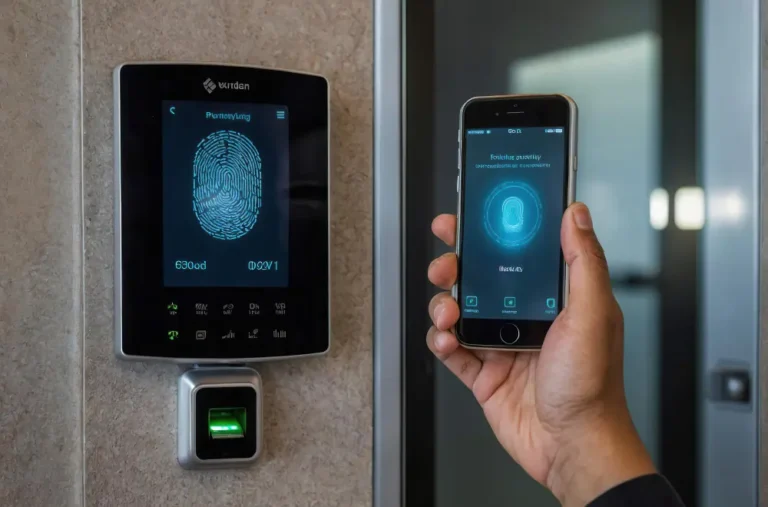How Biometric Access Control Enhances Building Security
In today’s world, security challenges for modern buildings have grown far beyond just locking doors and installing CCTV cameras. Whether it’s a corporate office, residential complex, government facility, or industrial site, unauthorized access can lead to serious safety risks, theft, or even data breaches. Biometric access control systems are transforming how buildings protect their premises, offering a level of security and convenience that traditional methods simply cannot match.
From fingerprint scanners to facial recognition and iris scanning, biometrics are no longer futuristic concepts — they are becoming the standard for high-security buildings. Let’s explore how biometric access control enhances building security and why it’s becoming a preferred choice across industries.
What Is Biometric Access Control?
Biometric access control is a security system that uses unique physical or behavioral characteristics of individuals to verify their identity and grant access to a secured area. Instead of relying on keys, ID cards, or passwords, biometric systems identify people using features such as:
- Fingerprint patterns
- Facial recognition
- Iris or retina scanning
- Voice recognition
- Palm or vein patterns
Because these traits are unique to each individual, biometric systems significantly reduce the chances of identity fraud or unauthorized access.
The Limitations of Traditional Access Methods
Before understanding the benefits of biometrics, it’s important to know why traditional security methods are often inadequate.
1. Keys and access cards can be lost or stolen
Keys and RFID cards can easily fall into the wrong hands. If stolen, they can be used without detection until the loss is reported.
2. Passwords can be shared or hacked
PINs and passwords are vulnerable to guessing, phishing attacks, or unauthorized sharing among employees.
3. No real-time identity verification
Traditional systems only verify possession of the access medium, not whether the person using it is the authorized owner.
These gaps have driven organizations to adopt biometric technology, which verifies the person, not just the tool they carry.

How Biometric Access Control Improves Building Security
1. Eliminates the Risk of Shared or Stolen Credentials
Biometric identifiers like fingerprints or facial features cannot be lent, stolen, or forgotten. This ensures only authorized individuals can enter, drastically reducing the risk of intrusions.
2. Provides Accurate and Instant Identity Verification
High-speed biometric systems can identify and authenticate users within seconds, even in high-traffic areas. This makes them ideal for offices, airports, hospitals, and other busy facilities.
3. Supports Multi-Factor Authentication (MFA)
For higher security, biometrics can be combined with PINs or access cards as part of MFA. This double-layer protection ensures that even if one factor is compromised, unauthorized entry is still impossible.
4. Tracks and Logs All Access Attempts
Biometric systems maintain detailed logs of every access attempt, including unsuccessful ones. This helps security teams investigate suspicious activities and maintain compliance with safety regulations.
5. Enhances Visitor and Contractor Management
Temporary biometric profiles can be created for visitors or contractors, allowing restricted access for a defined period. This ensures they can only enter approved areas during authorized times.
Types of Biometric Systems Used in Building Security
Fingerprint Recognition
The most widely used form of biometric access, fingerprint recognition offers quick authentication with minimal equipment cost. Modern systems use advanced sensors to prevent spoofing with fake fingerprints.
Facial Recognition
Using AI-powered cameras, facial recognition systems verify individuals even in varying lighting conditions. This is increasingly used in high-security offices, airports, and smart buildings.
Iris and Retina Scanning
These are highly secure and accurate methods, as the patterns in the iris or retina are unique and difficult to replicate. They are common in research labs, data centers, and defense facilities.
Palm Vein Recognition
Palm vein scanning captures vein patterns beneath the skin, making it extremely hard to duplicate. It’s contactless and ideal for hygienic access control in healthcare environments.
Voice Recognition
Though less common for physical entry points, voice recognition is used in combination with other systems for multi-layer security.
Integration with Smart Building Technology
Biometric access control is not just a standalone system — it works best when integrated with other smart building technologies:
- CCTV surveillance: Automatically triggers recording when an unauthorized access attempt is detected.
- Alarm systems: Sends instant alerts to security personnel during forced-entry attempts.
- IoT devices: Enables remote monitoring and control of access points through mobile apps.
- Time and attendance systems: Tracks employee attendance without manual check-ins.
By combining biometrics with building automation systems, security teams gain full visibility and control over who enters, when, and for how long.
Also read: The Difference Between Smoke Alarms and Fire Alarms
Advantages for Different Sectors
Addressing Security Concerns in Biometric Systems
- Encrypted data storage: Store biometric templates in encrypted formats to prevent misuse.
- Compliance with regulations: Follow GDPR, India’s Digital Personal Data Protection Act, or other local privacy laws.
- Regular system updates: Keep firmware and software up to date to prevent cyberattacks.
- Fallback access methods: Maintain alternative entry methods during power outages or system failures.
Future of Biometric Access Control in Building Security
The future of building security is moving toward touchless, AI-driven biometric systems. Emerging trends include:
- 3D facial recognition: More accurate and resistant to spoofing using masks or photos.
- Behavioral biometrics: Identifying people based on walking patterns, typing speed, or gesture recognition.
- Cloud-based biometric access: Allowing centralized management of multiple buildings from anywhere.
- Integration with mobile devices: Using smartphones as portable biometric scanners for access control.
With advancements in machine learning and AI, biometric systems will become even faster, more accurate, and more affordable, making them the standard for modern building security.
Final Thoughts
Biometric access control is more than just a high-tech convenience — it is a critical layer of defense for buildings of all sizes. By eliminating the weaknesses of traditional access methods, providing instant verification, and integrating seamlessly with other smart security systems, biometrics offer unmatched protection against unauthorized entry.
Whether for a small office or a multi-building campus, implementing biometric access control enhances safety, boosts operational efficiency, and delivers peace of mind for building owners, employees, and residents alike.
In a time where security threats are increasingly sophisticated, investing in biometric access control is no longer optional — it’s essential for safeguarding both people and assets.
